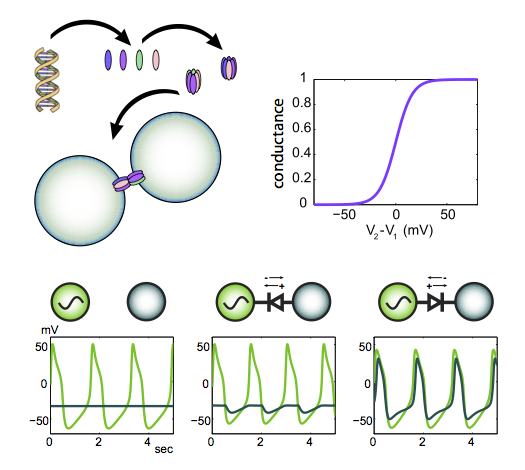In a paper appearing in last week’s issue of Neuron, members of the Sengupta Lab and their collaborators from the Bargmann Lab describe how a fixed neural circuit produces multiple behaviors in a context-dependent manner. The study was led by former Brandeis post-doctoral fellow Kyuhyung Kim in the Sengupta Lab (currently Assistant Professor at DGIST, Korea) and Rockefeller student Heeun Jang in the Bargmann Lab. Also involved in the study were current Brandeis MCB students Scott Neal and Danna Zeiger, and Dongshin Kim, the head of the Brandeis Microfluidics Facility.
 For this study the researchers used the nematode Caenorhabditis elegans. The nervous system of C. elegans consists of only 302 neurons (in the adult hermaphrodite) whose anatomical connectivities are well-mapped. Despite its relatively small nervous system, C. elegans exhibits a wide range of behaviors in response to environmental stimuli. For instance, C. elegans exhibits varied responses to pheromones – small chemical substances used for intra-specific communication. Some pheromones are repulsive to adult hermaphrodite C. elegans but neutral to male C. elegans. However, reducing the function of the neuropeptide Y-like receptor NPR-1 results in hermaphrodites now exhibiting neutral pheromone responses and males becoming strongly attracted. The researchers asked how the sex and neuromodulatory state of the animal allows it to interpret the pheromone stimulus differently to generate distinct behavioral responses.
For this study the researchers used the nematode Caenorhabditis elegans. The nervous system of C. elegans consists of only 302 neurons (in the adult hermaphrodite) whose anatomical connectivities are well-mapped. Despite its relatively small nervous system, C. elegans exhibits a wide range of behaviors in response to environmental stimuli. For instance, C. elegans exhibits varied responses to pheromones – small chemical substances used for intra-specific communication. Some pheromones are repulsive to adult hermaphrodite C. elegans but neutral to male C. elegans. However, reducing the function of the neuropeptide Y-like receptor NPR-1 results in hermaphrodites now exhibiting neutral pheromone responses and males becoming strongly attracted. The researchers asked how the sex and neuromodulatory state of the animal allows it to interpret the pheromone stimulus differently to generate distinct behavioral responses.
To answer this question, the researchers used behavioral assays, genetic manipulations of neuronal output, and in vivo measurements of pheromone-induced neuronal activity (using genetically encoded calcium sensors and customized microfluidics devices designed by the Brandeis Microfluidics Facility). They found that flexible output of a neuronal ‘hub-and-spoke’ circuit motif was responsible for generating these distinct pheromone responses under different conditions.
In this circuit, pheromone-sensing neurons ASK and ADL are connected to the central RMG motor/interneuron by gap junctions (see Figure). Jang et al. showed that in hermaphrodites with high levels of NPR-1 activity, the ADL sensory neurons respond strongly to a specific pheromone component and drive avoidance behavior via their chemical synapses to command interneurons for locomotion. However, sexual dimorphism in the circuit results in males having reduced ADL pheromone responses. Moreover, Jang et al. showed that ADL synaptic output in males is further decreased via RMG and ASK-mediated antagonism (see Figure). As a result, males are indifferent to this pheromone.
 The next issue the authors addressed is the role of NPR-1 activity in regulating pheromone responses. The Bargmann Lab had previously shown that high NPR-1 activity inhibits RMG, and under these conditions, pheromone responses of the ASK sensory neurons are low. Conversely, when NPR-1 activity is reduced or absent, ASK pheromone responses are enhanced. Jang et al. found that in the absence of NPR-1 activity, ADL chemical synaptic output in response to pheromones is antagonized by the RMG-ASK gap junction circuit. In other words, avoidance mediated by ADL chemical synaptic output is balanced by attraction mediated by the RMG-ASK gap junction circuit, resulting in hermaphrodites being neither attracted to nor avoiding this pheromone. In males with reduced NPR-1 activity the same effects are observed, however, since the ADL pheromone response is already lower in males, the RMG-ASK attraction-mediating arm “wins” resulting in attraction to pheromones. The authors refer to these as overlapping ‘push-pull’ circuits in analogy with electronic circuits.
The next issue the authors addressed is the role of NPR-1 activity in regulating pheromone responses. The Bargmann Lab had previously shown that high NPR-1 activity inhibits RMG, and under these conditions, pheromone responses of the ASK sensory neurons are low. Conversely, when NPR-1 activity is reduced or absent, ASK pheromone responses are enhanced. Jang et al. found that in the absence of NPR-1 activity, ADL chemical synaptic output in response to pheromones is antagonized by the RMG-ASK gap junction circuit. In other words, avoidance mediated by ADL chemical synaptic output is balanced by attraction mediated by the RMG-ASK gap junction circuit, resulting in hermaphrodites being neither attracted to nor avoiding this pheromone. In males with reduced NPR-1 activity the same effects are observed, however, since the ADL pheromone response is already lower in males, the RMG-ASK attraction-mediating arm “wins” resulting in attraction to pheromones. The authors refer to these as overlapping ‘push-pull’ circuits in analogy with electronic circuits.
These results begin to explain how a small fixed circuit can generate a remarkable range of behaviors via alteration of sensory response properties as well as choice of specific synaptic output pathway as a function of neuromodulatory state and sex. The general theme of a circuit functioning differently under different neuromodulatory conditions has been extensively studied in the Marder Lab in the crustacean nervous system, and is an important principle to be kept in mind when interpreting functionality from structurally described connectomes.
Jang H(*), Kim K(*), Neal SJ, Macosko E, Kim D, Butcher RA, Zeiger DM, Bargmann CI, Sengupta P. Neuromodulatory State and Sex Specify Alternative Behaviors through Antagonistic Synaptic Pathways in C. elegans. Neuron. 2012;75(4):585-92.






